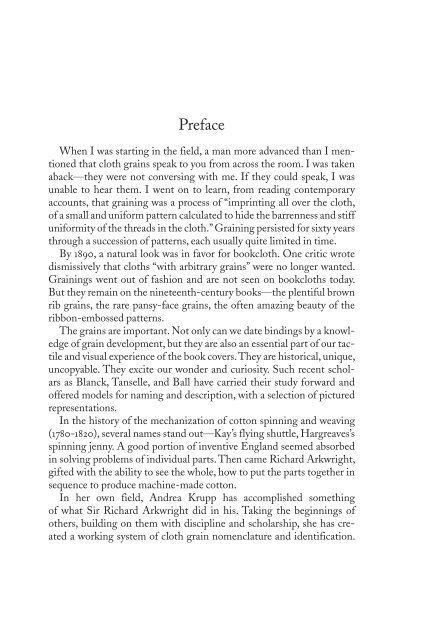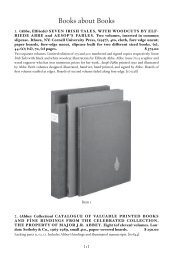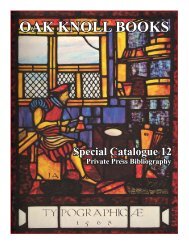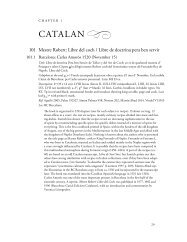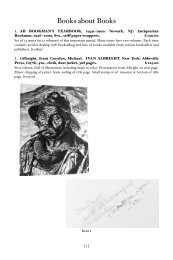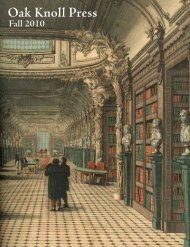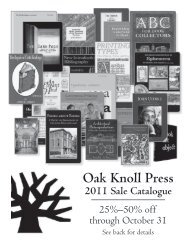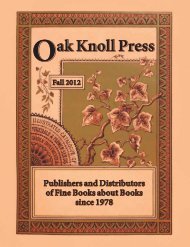View Excerpt (PDF) - Oak Knoll Books
View Excerpt (PDF) - Oak Knoll Books
View Excerpt (PDF) - Oak Knoll Books
You also want an ePaper? Increase the reach of your titles
YUMPU automatically turns print PDFs into web optimized ePapers that Google loves.
Bookcloth in England and America, 1823–50<br />
vii<br />
Preface<br />
When I was starting in the field, a man more advanced than I mentioned<br />
that cloth grains speak to you from across the room. I was taken<br />
aback—they were not conversing with me. If they could speak, I was<br />
unable to hear them. I went on to learn, from reading contemporary<br />
accounts, that graining was a process of “imprinting all over the cloth,<br />
of a small and uniform pattern calculated to hide the barrenness and stiff<br />
uniformity of the threads in the cloth.” Graining persisted for sixty years<br />
through a succession of patterns, each usually quite limited in time.<br />
By 1890, a natural look was in favor for bookcloth. One critic wrote<br />
dismissively that cloths “with arbitrary grains” were no longer wanted.<br />
Grainings went out of fashion and are not seen on bookcloths today.<br />
But they remain on the nineteenth-century books—the plentiful brown<br />
rib grains, the rare pansy-face grains, the often amazing beauty of the<br />
ribbon-embossed patterns.<br />
The grains are important. Not only can we date bindings by a knowledge<br />
of grain development, but they are also an essential part of our tactile<br />
and visual experience of the book covers. They are historical, unique,<br />
uncopyable. They excite our wonder and curiosity. Such recent scholars<br />
as Blanck, Tanselle, and Ball have carried their study forward and<br />
offered models for naming and description, with a selection of pictured<br />
representations.<br />
In the history of the mechanization of cotton spinning and weaving<br />
(1780-1820), several names stand out—Kay’s flying shuttle, Hargreaves’s<br />
spinning jenny. A good portion of inventive England seemed absorbed<br />
in solving problems of individual parts. Then came Richard Arkwright,<br />
gifted with the ability to see the whole, how to put the parts together in<br />
sequence to produce machine-made cotton.<br />
In her own field, Andrea Krupp has accomplished something<br />
of what Sir Richard Arkwright did in his. Taking the beginnings of<br />
others, building on them with discipline and scholarship, she has created<br />
a working system of cloth grain nomenclature and identification.
viii<br />
Andrea Krupp<br />
Advances in photographic reproduction allow the showing of a picture<br />
of every grain, referenced by name and number. To me the most valuable<br />
feature is the precise date span assigned to each grain—provisionally,<br />
since this is a system destined to expand.<br />
Now, in truth, cloth grains speak a language—a language we can all<br />
learn to read. Andrea’s book provides its dictionary and grammar—concise,<br />
handy, indispensable. It would be impossible to embark on any consideration<br />
of cloth grains without it.<br />
Sue Allen
Bookcloth in England and America, 1823–50<br />
ix<br />
Acknowledgements<br />
I would like to acknowledge the support and assistance of my friends<br />
and colleagues at the Library Company. From the very beginning of<br />
this project, Chief of Conservation Jennifer W. Rosner has been a close<br />
collaborator. Her organized mind shaped the Database of 19th-Century<br />
Cloth Bindings, from which my data for this research and the Catalogue<br />
of 19th-Century Bookcloth Grains was drawn. Her dogged persistence<br />
over a span of twelve years gave the momentum to this very large, ambitious<br />
project, and thanks to her efforts, the Database is finally in the last<br />
stages of preparation for mounting online. Curator of Printed <strong>Books</strong><br />
Wendy Woloson provided invaluable help with her skillful editing. Also,<br />
with her sharp eyes and curator’s purse she enthusiastically helped to<br />
build the Library Company’s collection of 19th-century cloth bindings.<br />
Early on, Librarian Jim Green recognized the potential utility of my<br />
research and offered unwavering support along the way, and I credit<br />
Director John Van Horne for fostering a work environment that values<br />
staff involvement with the collections. Sharon Hildebrand and Linda<br />
Wisniewski provided expertise in scanning the grain patterns, and<br />
Jenny Ambrose continues to be a key resource for navigating the technological<br />
intricacies of mounting the Database of 19th-Century Cloth<br />
Bindings, and soon, the Catalogue of 19th-Century Bookcloth Grains<br />
online. Thank you to all of my colleagues in the McLean Conservation<br />
Department: Alice Austin and Kristin Balmer, as well as the rest of the<br />
staff of the Library Company in the Cataloging Department, the Print<br />
and Photograph Department, the reading room, and administration.<br />
Special thanks to Michael Zinman, head cheerleader of this project<br />
from its inception. He has been an important contributor intellectually,<br />
materially, and financially.<br />
The compilation of grain patterns in the CBG was a group effort, and<br />
I thank all the contributors whose sharp eyes and minds have enriched<br />
my work. Todd Pattison, Willman Spawn, Sue Allen, Steve Beare,<br />
Tom Kinsella, and Robert Milevski provided not only contributions of
Andrea Krupp<br />
patterns but also intellectual exchange. Todd Pattison contributed four<br />
new patterns: Dia14, Ft44, As14 and Gs3. Stuart Walker of the Boston<br />
Public Library made a significant contribution of fourteen new patterns.<br />
As13, Fs18, Fs19, Fs20, Ft41, Ft42, Ft43, Ft47, Gs1, Gs2, Gt20, Gt21, Gt22<br />
and Gt23 appear courtesy of the Boston Public Library, and I thank<br />
them for providing scans of these patterns. Ft29 appears courtesy of the<br />
Athenaeum of Philadelphia. At17 and As15 appear courtesy of Steve<br />
Beare. I gleaned two patterns from the Publishers’ Bindings Online<br />
website: Ft45 and Ft46; these images appear courtesy of the W.S. Hoole<br />
Special Collections Library at the University of Alabama.
Bookcloth in England and America, 1823–50<br />
<br />
Bookcloth in England and America, 1823–50<br />
Part 1: Early Bookcloth<br />
In 1823, a London bookbinder named Archibald Leighton collaborated<br />
with a dyer to transform plain cotton fabric into a material suited<br />
to the covering of books. Bookcloth, as it came to be known, was easy<br />
to work with, easy to decorate, and much cheaper than leather. The new<br />
binding material soon revolutionized bookbinding — both the process<br />
and the product — in England and America. Book historians such as<br />
Michael Sadleir, John Carter, Joseph Rogers, Douglas Ball, and most<br />
recently William Tomlinson and Richard Masters have told this story<br />
of invention. However, the history of the early period of bookcloth,<br />
from the ‰rst experiments up to the time when manufacturers perfected<br />
the product and launched an industry, from 1823 to about 1850, remains<br />
frustratingly obscure.<br />
Little is known about how, where, and by whom early bookcloth was<br />
produced. Primary source material that would provide documentary<br />
evidence about the manufacture and use of bookcloth during the ‰rst<br />
decades of its existence, such as advertisements, patents, and publishers’<br />
and binders’ records, remains scarce. However, cloth-bound books<br />
Douglas Leighton, “Canvas and Bookcloth: An Essay on Beginnings,” The<br />
Library, 5th ser., 3 ( June 1948): 39-49.<br />
Michael Sadleir, The Evolution of Publishers’ Binding Styles, 1770–1900 (London:<br />
Constable; New York: R. R. Smith, 1930); John Carter, Binding Variants (London:<br />
Constable and Company, 1932); Joseph W. Rogers, “The Rise of American Edition<br />
Binding” in Bookbinding in America, ed. H. Lehmann-Haupt (New York: R. R.<br />
Bowker, 1941); Douglas Ball, Victorian Publishers’ Bindings (Williamsburg, VA:<br />
Bookpress, 1985); William Tomlinson and Richard Masters, Bookcloth, 1823–1980<br />
(Mellor, Stockport, Cheshire: Dorothy Tomlinson, 1996)<br />
Some of the earliest U.S. patents exist only as subject entries in an index, the
Andrea Krupp<br />
themselves are a rich source of empirical information, and repositories<br />
such as the Library Company of Philadelphia hold them in plentiful<br />
supply. Since 1995, the Library Company’s Chief of Conservation,<br />
Jennifer Woods Rosner, and I have been compiling data about the structure<br />
and appearance of cloth-covered bindings in our collection. The<br />
Database of Nineteenth-century Cloth Bindings currently contains<br />
data on approximately 3,000 books published between 1824 and 1900.<br />
Each entry comprises over sixty ‰elds of information that record the<br />
details of the book’s structure and appearance. This article focuses on<br />
two of those recorded elements: the date of publication as given on the<br />
title-page and the grain of the cloth. While compiling the database we<br />
identi‰ed 160 new bookcloth grain patterns. The majority of them,<br />
135, ‰rst appear on American books published before 1850. By way of<br />
comparison, current resources illustrate ‰fty-seven diˆerent bookcloth<br />
grains, and only seventeen of them are pre-1850 patterns.<br />
The study of nineteenth-century bookbindings is advancing with<br />
increased attention to the materiality of the book and the information<br />
that can be gleaned from it, because documentary evidence is so rare.<br />
Accordingly, the study of bookcloth grain patterns by necessity must<br />
progress towards increasingly detailed and speci‰c identi‰cation and away<br />
from generalized divisions of grain patterns by family. The large number<br />
of bookcloth grains that has been amassed underscores the need for a<br />
detailed and accurate “‰eld guide” that records individual cloth grain patactual<br />
patents having burned in the great Patent O‹ce ‰re of 15 December 1836.<br />
Three of these were especially promising: a ribbon smoothing and glossing machine,<br />
1817; cloth dressing and ornamenting, 1821; manufacture of ‰gured fabrics, 1834.<br />
Both totals include 104 “ribbon-embossed” patterns. These decorative bookcloth<br />
grain patterns in Šoral, geometric, and abstract designs are discussed later in<br />
this article. Their dates of use range from the early to mid-1830s through the 1840s.<br />
Photographs of cloth grains appear in the following books: Sadleir, The<br />
Evolution of Publishers’ Binding Styles; Carter, Binding Variants; Rogers, “The Rise<br />
of American Edition Binding”; Sadleir, XIX Century Fiction: A Bibliographical<br />
Record Based on His Own Collection, 2 vols. (London: Constable; Berkeley, CA:<br />
California Univ. Press, 1951; reprinted, 1969); Jacob Blanck and Michael Winship,<br />
Bibliography of American Literature, 9 vols. (New Haven, CT: Yale Univ. Press, 1955–<br />
91); G. Thomas Tanselle, “The Bibliographical Description of Patterns,” Studies in<br />
Bibliography 23 (1970): 71–102; Philip Gaskell, A New Introduction to Bibliography<br />
(Oxford: Clarendon, 1972); Ball, Victorian Publishers’ Bindings.
Bookcloth in England and America, 1823–50<br />
<br />
terns. For example, current resources illustrate two rib grains, but we have<br />
identi‰ed ten diˆerent rib grains, each with a quanti‰able distinguishing<br />
characteristic. Furthermore, each one is associated with a limited range of<br />
dates, and eight of these rib-grain patterns ‰rst appear before 1850. Acute<br />
diagonal rib (rib9) is an example of a highly individual, easily recognizable,<br />
and potentially signi‰cant early rib-grain pattern. I have recorded<br />
nine examples of acute diagonal rib at the Library Company, and all date<br />
from 1832 to 1837. Though rare, examples of this unique grain will seem to<br />
pop oˆ the shelf once your eyes have learned to spot it.<br />
In all, 247 grain patterns have been assembled to create a new “‰eld<br />
guide” for identifying and dating nineteenth-century bookcloth. The<br />
Catalogue of Nineteenth-century Bookcloth Grains (CBG) appears in<br />
its entirety at the end of this article. The existing “descriptive” nomenclature<br />
of cloth grains provided a model for naming new patterns that<br />
was followed whenever possible. It is important to remember that the<br />
data presented in the CBG is drawn primarily from the Database of<br />
Nineteenth-century Cloth Bindings. Approximately one-quarter of the<br />
cloth bindings in the Library Company of Philadelphia’s collection of<br />
predominantly pre-1860 American imprints has been entered into the<br />
database to date. Seventy-one percent of the new grain patterns appear<br />
on American books printed before 1850, which may be partly due to the<br />
strong representation in our collection, and accordingly, the database, of<br />
pre-1860 imprints. But I believe that the diversity of cloth-grain patterns<br />
extant before 1850 is in itself an important and previously unrecognized<br />
aspect of the early history of bookcloth manufacture. Beyond amassing<br />
cloth grain varieties, the CBG records the dates of use for each grain<br />
as recorded in the Database of Nineteenth-century Cloth Bindings. <br />
Larger pools of data for both English and American imprints must be<br />
This total includes 25 new patterns added to the CBG since the first printing<br />
of this article.<br />
Part 2 of this article addresses the issues of nomenclature and descriptive vs.<br />
code-based systems of identi‰cation.<br />
Bearing in mind the publishers’ practice of binding up parts of an edition sometimes<br />
many years after its initial publication, the dating of a particular bookcloth<br />
grain based solely upon the year of imprint can be unreliable. However, after examining<br />
thousands of examples of nineteenth-century cloth-bound books, one develops<br />
an eye for the “solitary exception,” as Carter put it, and the discipline to regard<br />
it with suspicion.


